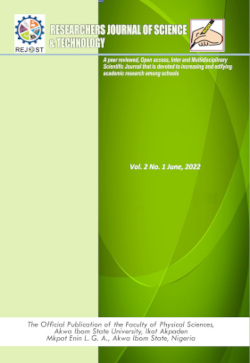Reservoir Characterization, petrophysical analysis and prospect identification of ‘UQ’ field, southern Niger Delta, Nigeria
Keywords:
Well Logs, Seismic Section, Petrophysics, Prospect, Hydrocarbon, VolumetricAbstract
The prospect evaluation of the UQ field using integrated 3D seismic and well log data from four wells (UQ-12, UQ-3, UQ-4 and UQ-5) has been carried out in this research. The study identified and assessed the plays, prospects, and components of the petroleum system within the ‘UQ’ Field to determine its actual potential and its economic viability for investment and development. The well logs and seismic data were incorporated to delineate four hydrocarbon bearing reservoirs and quantitatively estimate their prospectivity. The reservoirs (R_1, R_2, R_3 and R_4) were correlated across the field, with some appreciable reduction in net sand down dip. Structural analysis has been carried out using seismic data, which aided in the mapping of major, antithetic, and synthetic faults with four horizons (constrained by identified reservoir sand from the logs) that were gridded to create top structural maps. Petrophysical results using well log derived parameters and time-depth structural maps were obtained. Surface attributes, which are highly amplitude supported, were utilized to capture prospective zones better. The study showed that the R_1 reservoir has a very good porosity of 30%, an appreciable shale volume of 39%, and a high hydrocarbon saturation of 89% with an oil and gas phase. Similarly, the R_3 reservoir comprises shaly sands with very good average porosity of 27% and high average hydrocarbon saturations of 68%. Surface attribute analysis reveals the existence of hydrocarbon-bearing closures characterized by moderate to high root mean square amplitude and average energy values within R4 sand at the north eastern and south western parts of the field. These values are closely consistent with those obtained for R-2, which hosts the producing wells. Using these methods, this study has unravelled two new prospective zones with economical hydrocarbon volumes within the R_4 reservoir allowing for increased hydrocarbon volumes from the already producing field. Overall, the project aims to provide valuable insights into the technical, economic, and environmental aspects of the UQ field, which can contribute to informed decision-making and the sustainable development of Nigeria's energy sector.
References
Achie, G. (1942). The Electrical Resistivity log as an Aid in determining some reservoir characteristics transection of the AIME,146, 54-62.
Aigbedion, H. O. Aigbedion. (2011). Petrophysical analysis of two onshore wells in the Niger Delta Nigeria, Jonrnal of Science and Technology, Vol.4, 2004, pp. 56-59.
Akpabio, U., Ejele, C., & Ibe, A. (2017). Reservoir characterization of the UQ Field, eastern Niger Delta, Nigeria: A petrographic and petrophysical approach. Journal of Petroleum Exploration and Production Technology, 7(2), 577-587.
Akpan, E. M., & Okon, E. A. (2018). Evaluation of reservoir potential and hydrocarbon saturation in the UQ field, Niger Delta, Nigeria. International Journal of Scientific &Engineering Research, 8(12), 10-19.
Asuquo, E. F., & Nwankwoala, H. O. (2018). Optimal development planning for the ‘UQ’ Field, Niger Delta Basin. Arabian Journal of Geosciences, 11(21), 647.
Doust, H. and Omatsola, E. (1990). Niger Delta, in, Edwards, J. D., and Santogrossi, P.A., eds., Divergent/passive Margin Basins, AAPG Memoir 48: 239-248.
Edwards, J. D., & Santogrossi, P. A, (1990). Divergent/Passive margin basins, AAPG 48, Tulsa, 239-248
Ehinola, O.A. and Akinbodewa, O. (2017). Uncertainty in Quantification and Ranking of Stock Tank Oil Initially in Place (STOIIP) in OA Field, Niger Delta. In Unconventional Resources Technology Conference, Denver, Colorado. 2524-2533.
Essien, N, B. O. Ekpo, P, A, Neji & R. O. Etsenake. (2018). Geochemical finger -printing of western offshore Niger Delta Oils. Journal of petroleum science & Engineering 160,452 – 464.
Etesin, U., Ite, A. E., Harry, T. A. and Bassey, C. E. (2015). Assessment of cadmium and lead distribution in the outcrop rocks of Abakaliki Anticlinorium in the Southern Benue Trough. Journal of Environment Pollution and Human Health, 3(2), 62-69.
Etu-Efeotor, J. O. (1997). Fundamentals of petroleum geology. Africana - Fep Publishers, Onitsha, Nigeria, 111-123.
Harry, T. A. and Akata, N. I. (2019). Evaluation of Shale Volume and effective porosity from wire line logs in “Watty” Field, Niger Delta, Nigeria: International Journal of Scientific & Engineering Research. Volume 10, Issue 12, pages 1150-1158 (U.S.A).
Ibe, A., & Adekoya, J. (2020). Maximizing hydrocarbon recovery in UQ field: Case study of infill drilling optimization. Journal of Petroleum Exploration and Production Technology, 9(1), 365-376.
Oyinloye, A. O. (2016). Analysis and interpretation of geochemical data from iperindo lode gold deposit using the isochon method”, Global Journal of pure and applied science, vol. 6, No. 2, 2000, pp. 263- 270.
Reijers, T. J. A., Petters, S. W. and Nwajide, C. S. (1996). The Niger Delta Basin. In: Reijers, T.J.A., Ed., Selected Chapters on Geology, Sedimentary Geology and Stratigraphy in Nigeria, SPDC, Nigeria, 103-117.
Short, K. C. and Stauble, A. J. (1975). Outline of geology of Niger Delta. AAPG Bulletin. 51(5), 761 - 799.
Weber, K. J. and Daukoru, E. M. (1975). Petroleum Geology of the Niger Delta: Proceedings of the ninth World Petroleum Congress, volume 2, Geology: London, Applied Science Publishers, Ltd.: pp. 56-58.

Downloads
Published
How to Cite
Issue
Section
License
Copyright (c) 2023 Researchers Journal of Science and Technology

This work is licensed under a Creative Commons Attribution-NonCommercial-NoDerivatives 4.0 International License.




